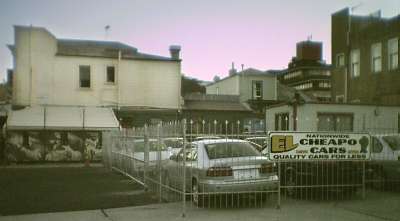When I wrote about
the potential demolition of the Il Casino building, there was an ominous anonymous comment about plans already existing for redevelopment. I've since heard rumours that these plans may just involve building on the open portion of the site rather than demolishing the whole building, and may just be speculative designs to assess the potential of the site rather than a sign of definite intent. That's slightly reassuring, but I still remain apprehensive.
Among the comments on that post, I
mentioned the planned redevelopment of another pioneering restaurant site:
the Settlement in Willis St.
Harry Seresin was as much an inspiration to Wellington's hospitality scene as Remiro Bresolin has been, and while the old building has suffered some indignities since then (the Lions HQ!) it has at least survived. For a while there were plans in the window advertising its replacement by apartments, but they had disappeared for a few months and I couldn't find it mentioned online, so I wondered whether the plans had fallen through. Recently, though, a rendering of the proposed building has been sporadically visible in the window, and I managed to grab a blurry photo of it.

It's not pretty. It seems to be by the same developer and architect (Stratford Properties,
Cockburn Architects) as the nearly complete
Stratford apartment/hotel development across the road at 156 Willis St. That building is let down by a gratuitous travesty of a cornice and a shade of green that somehow manages to be simultaneously bland and bilious, but at least it has the virtue of slenderness when seen from Willis St. This one is a little shorter (12 storeys) but three times the width, muscling right up to
Roti on one side and
Mojo Invincible on the other. There have at least been some attempts to break down that imposing bulk by modulating the roofline, but then they've ruined it by tacking on folksy curvy bits of facade, presumably in deference to the existing
Settlement, since none of its neighbours have anything of the sort. But what worked on a colonial two-storey shopfront doesn't belong on a concrete high-rise, and the result looks like a Wild West film set blown up on a malfunctioning photocopier.
I have a lot of respect for
Daryl Cockburn's environmental activism, and with groups such as
Transport 2000+,
Cycle Aware Wellington and
Living Streets Aotearoa he has been a welcome advocate for sustainable transport and urban form. However, I have to make a personal judgement (as a layperson) and say that I don't think his buildings are great advertisements for high-density urban living. What he describes as "
classical timeless principles" looks to me more like the sort of plasterboard faux-historical gimcrackery that characterised the worst of 1980s postmodernism.
It might be instructive to apply the
Architecture Centre's
Manifesto for Architecture to this proposal and see how it matches up:
1)
Architecture must be better than what it replaces (Fresh air is better than some buildings)
2)
Architecture relies on intelligent government (Mindless bureaucracy will only create mindless architecture)
3)
Architecture needs an assertive public (Architecture will only thrive if the public demand this)
4)
Urban Environments must be planned (but not only by planners)
5)
Recycle Architecture; Good architecture is elegant environmentalism (Continued human existence relies on having planet earth in our future; ditto for the next planet)
6)
Architecture must facilitate better living (The delights of good design - light, warmth and pleasure etc - must be cherished)
7)
Bad building must be eliminated (Wellington is too important for soulless building; buildings designed heartlessly for profit are not architecture)
8)
Architecture must be celebrated (New architecture is our future heritage)
9)
Architecture has an obligation to challenge (Controversy has a positive role in architecture)
Hmm. A lot of this comes down to aesthetic preference, but already points 1 and 7 are looking a bit shaky. It ignores rule 5, and number 6 is more about amenity for the residents, which is hard to comment on. It's hard to see this being the sort of thing that would be celebrated as heritage in the future, so it falls down on point 8. Its very blandness is what's offensive about it, so number 9 doesn't apply. If we followed point 3 the public might have been able to influence this development for the better, but since this was presumably non-notified (the height doesn't break the District Plan) we haven't had a chance. For that, we can probably blame a failure of points 2 and 4.
Is it too late to achieve a better outcome for the city? The demolition of the
Settlement building, while regrettable for its historical importance, is not a terrible loss. A building of this size and location is justifiable on the grounds of increased residential density, and the bulk, while considerable, is probably manageable. It's just the facade that makes it look so cheap and depressing. I believe that it should be possible to come up with a surface treatment that's much more interesting, and that actually enlivens the street, without costing vastly more. The development is yet to start, so nothing is inevitable, but is there any mechanism through which the public, and the architectural community, can ensure that the result is something to be celebrated?
 The latest newsletter from Wellington Waterfront Ltd includes an update on landscaping work at Taranaki St Wharf West. The first stage starts in a few weeks time and should take about six weeks, and will involve converting the 8 metre high mound into a 1.5 metre high sloping lawn, with a wide pedestrian thoroughfare between Jervois Quay and the wharf. The second stage will link the Ambulance building with Taranaki St Wharf while temporarily asphalting the site of the proposed wharewaka, and should be ready by the start of November.
The latest newsletter from Wellington Waterfront Ltd includes an update on landscaping work at Taranaki St Wharf West. The first stage starts in a few weeks time and should take about six weeks, and will involve converting the 8 metre high mound into a 1.5 metre high sloping lawn, with a wide pedestrian thoroughfare between Jervois Quay and the wharf. The second stage will link the Ambulance building with Taranaki St Wharf while temporarily asphalting the site of the proposed wharewaka, and should be ready by the start of November.







 The
The 

















 Krazy Lounge has Konked out. There's a sign on the door saying "Sorry, Krazy Lounge is closed forever. R.I.P.", and the inside is currently being used as a temporary sale shop for the appropriately-named fashion label
Krazy Lounge has Konked out. There's a sign on the door saying "Sorry, Krazy Lounge is closed forever. R.I.P.", and the inside is currently being used as a temporary sale shop for the appropriately-named fashion label 

 It's not pretty. It seems to be by the same developer and architect (Stratford Properties,
It's not pretty. It seems to be by the same developer and architect (Stratford Properties, 
